Bulletin – March 2016 Australian Economy The Rise in Dividend Payments
- Download the article 861KB
Abstract
Dividends paid by Australian listed companies have grown substantially since the global financial crisis, most notably among large resources companies and the banks. These increases have occurred alongside modest growth in earnings. Dividend-paying companies appear to generally smooth these payments, having been reluctant to reduce their dividend payments in particular. The increase in dividends over recent years could reflect an increase in shareholder preferences to receive income payments or a perception among company managers that there are fewer viable investment opportunities; the data offer some modest support to both of these hypotheses.
Introduction
Dividends are cash payments that companies make to their shareholders. They represent a company's choice to return earnings to shareholders, instead of being used for other alternatives, including retaining earnings to fund investments internally or to strengthen its balance sheet or liquidity position. In 2015, Australian-domiciled listed companies announced that they would pay $78 billion in dividends (Graph 1). These payments represented 81 per cent of these companies' underlying earnings for the same period (the ‘payout ratio’) and 4.8 per cent of the market capitalisation of these companies as at end June 2015 (the ‘dividend yield’).
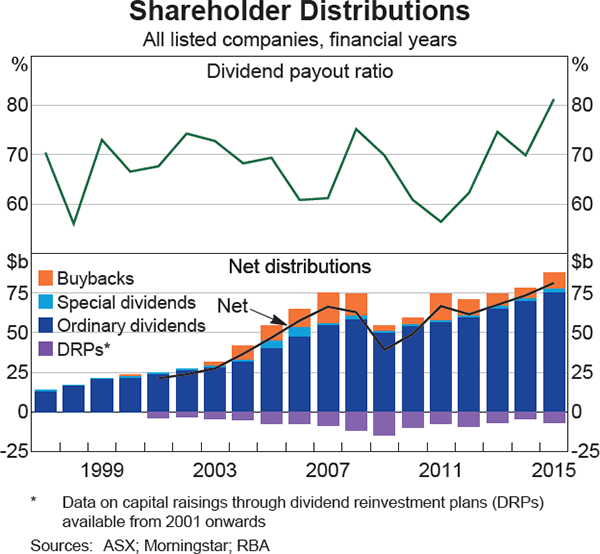
Australian companies' dividends are high by international standards (Table 1). This in part reflects the effect of tax policies, particularly Australia's system of dividend imputation, which was introduced in July 1987. Previously, Australia had a dual taxation regime under which earnings were taxed at both the company rate and at the applicable personal income tax rate for each receiving shareholder. Dividend imputation ensures that company profits paid to Australian residents as dividends are only taxed once.[1]
| Australia | 67 |
|---|---|
| United Kingdom | 60 |
| Japan | 57 |
| Europe | 55 |
| Canada | 52 |
| United States | 48 |
|
Sources: Bloomberg; Morningstar; RBA |
|
Dividend payments increased strongly between the 2010 and 2015 financial years, rising by roughly 40 per cent. ‘Ordinary’ dividends are a regular distribution of earnings to the shareholder, but companies can also make cash distributions to shareholders via one-off ‘special’ dividends or share buybacks. On the other hand, dividend reinvestment plans (DRPs) offer the opportunity for shareholders to return the funds to the company as an increased equity holding. The increase in net cash distributions has been driven by a rise in ordinary dividends rather than special dividends, which suggests that companies intended for this to be a more permanent increase in dividend payments.
Consistent with the increase in dividend payments, the dividend payout ratio has also risen and, in 2015, reached its highest level in more than a decade. This increase in dividends has occurred in an environment of relatively modest growth in earnings and over a period in which many companies have sought to reduce leverage. These developments have raised questions about the sustainability of dividend payments and the extent to which companies' dividend policies have committed them to a particular dividend payment level. In February this year, a number of companies announced reductions to their interim or final dividend payments and changes to their dividend policies, potentially reflecting concerns related to sustainability. Even so, the dividend payout ratio increased further. Shareholders may have also demanded higher dividends over recent years amid lower yields on traditional cash-paying bond-like investments and increased risk aversion. These developments have also highlighted the choices companies face between the potentially competing objectives of paying dividends, reducing balance sheet leverage and investing in productive capital.
Theories of Dividend Policy
A range of theories have been advanced to explain corporate dividend payments, though there is no agreement about how companies should make these choices.
Modigliani and Miller's (1961) theory of dividend irrelevance suggests that shareholders should be indifferent to being paid a dividend or not, given that in the latter case, higher retained earnings should be reflected in a higher share price. This is because dividends can be reinvested in shares, or alternatively some shares can be sold in exchange for cash, depending on the preferences of the shareholder. While this is a useful starting point for understanding dividend theory, a bias towards paying dividends emerges if transaction costs and differing tax treatments for capital gains and dividends exist, as they do in the Australian market.
Company boards may also be influenced by their shareholders' preferences for dividends, often referred to as the ‘clientele effect’ (Baker and Wurgler 2004). Shareholders' preferences may: be influenced by tax incentives, as mentioned above; differ by investor type, with retail investors thought to favour dividends over capital gains more than wholesale investors; and vary cyclically, with dividends providing an income stream in a lower growth environment and posing less of an opportunity cost in terms of the company's investment opportunities.
Furthermore, dividend payments are expected to vary over the firm's life cycle (Mueller 1972). ‘Growth’ stocks (such as junior exploration companies, IT start-ups or biotechnology firms) often initially have large investment expenditures relative to their earnings, have limited access to finance, and therefore typically pay fewer dividends. More mature firms, on the other hand, are generally more able to pay dividends given their access to more stable sources of funding and income. For more mature firms, dividend payments may also be seen as a signal of a positive outlook (Miller and Rock 1985). This can lead to firms placing some emphasis on smoothing dividends through time, as well as a reluctance to cut dividends when earnings fall.
Notwithstanding these theoretical considerations, it is not always clear how company boards decide on a particular dividend payment amount. A commonly cited survey of US company executives by Brav et al (2005) found that executives tended to first aim to maintain the level of dividends paid before making investment decisions and only later decide whether to increase dividends with any remaining cash. Buybacks were a favoured method to distribute residual cash and to retain flexibility over future distributions.
It is not clear whether Australian executives have followed similar decision-making processes, although public statements by some of the largest Australian listed companies regarding their dividend policies are not inconsistent with the conclusions of the Brav et al (2005) survey. Table 2 presents a summary of statements referring to dividend policies from the public documents of selected ASX 20 companies. Among the larger, well-known Australian companies, payout ratios are the most common policy mentioned, though there have also been other considerations. Progressive dividend policies (maintaining or increasing the dollar value of the dividend payment per share) or a preference for increasing dividends have been fairly common, consistent with a preference not to cut ordinary dividends.
Aggregate Trends
Since 2003, the aggregate dividend payout ratio has evolved in three broad phases: first, falling as dividends grew less strongly than earnings during the early high-investment stage of the resources boom; second, rising temporarily during the global financial crisis, as dividends fell but by less than earnings; and more recently, rising quickly alongside large increases in dividends while earnings have been, in aggregate, relatively flat (Graph 2). Notwithstanding the fact that many companies may target a particular payout ratio, in aggregate, payout ratios have increased significantly in recent years.
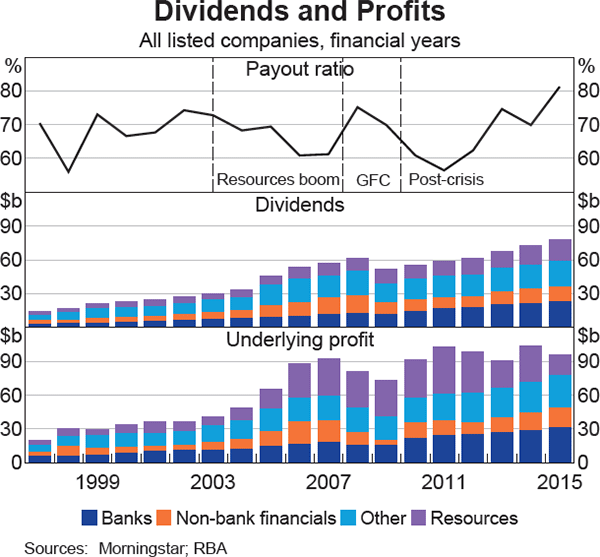
Comparing dividend payments to operating cash flows may more directly measure the ability of companies to pay announced dividends out of current period cash profits. If capital expenditure and dividends together exceed operating cash flow, a company will need to raise debt or equity or draw down on existing cash holdings to finance these expenditures. Such shortfalls may be interpreted as a firm paying out ‘excessive’ dividends, particularly if the shortfalls persist. Conversely, a dividend payment may be regarded by investors as ‘too small’ if the firm is accumulating cash without allocating it to a suitable investment opportunity. However, as mentioned above, dividend decisions may also be governed by other considerations, such as decisions the companies may make in relation to desired gearing levels, liquidity, future investment and, potentially, their commitment to an established dividend policy alongside a desire to meet shareholder expectations.
The ratio of dividend payments to operating cash flows has risen in recent years to be above 50 per cent, which is high by recent standards outside of the global financial crisis (Graph 3). Companies receive cash inflows from (net) operating income and financing activities (e.g. debt and equity raisings), while cash outflows are directed to investing activities and paying dividends. Throughout most of the period since the early 2000s, Australian companies were accumulating cash (that is, the ‘stock’ of cash holdings was increasing), most notably in the resources sector, which was benefiting from strong income during the resources boom (Graph 4). However, in the most recent year, net cash flows have turned negative. While not sustainable over an extended period of time, a negative cash flow in any one period could be motivated by a range of considerations, as mentioned above. Dividends relative to accumulated cash holdings on companies' balance sheets are not particularly high, at around historical averages. The following discussion examines behaviour by sector and company size for insights into recent dividend payment activity.
| Company | Dividend policy |
|---|---|
| AMP | A payout ratio of 70 to 90 per cent of underlying profit |
| BHP Billiton | A minimum payout ratio of 50 per cent, introduced in 2016. This replaces a long-standing progressive dividend policy that aimed to steadily increase or at least maintain the dividend per share in US dollar terms at each financial half year |
| Brambles | A progressive dividend policy, which seeks to maintain or increase dividends per share each year, in Australian cents, subject to its financial performance and cash requirements |
| Commonwealth Bank of Australia | A full-year payout ratio of 70 to 80 per cent |
| Insurance Australia Group | A full-year payout ratio of 60 to 80 per cent of cash earnings |
| Macquarie Group | A full-year ordinary dividend payout ratio of 60 to 80 per cent |
| National Australia Bank | A payout ratio of 70 to 75 per cent of cash earnings |
| QBE Insurance Group | A maximum payout ratio of annual cash profits of 65 per cent |
| Rio Tinto | Shifting to a payout ratio in the range of 40 to 60 per cent of underlying earnings through the cycle.(a) This replaces a long-standing progressive dividend policy that aimed to maintain or increase the US dollar value of ordinary dividends per share |
| Suncorp Group | An ordinary dividend payout ratio target of 60 to 80 per cent of cash earnings |
| Telstra Corporation | Within a broader capital management framework, to increase the dividend over time |
| Westpac Banking Corporation | Seeks to consistently lift ordinary dividends in terms of cents per share each half while maintaining a strong capital position to support growth |
| Wesfarmers | Seeks to deliver growing dividends over time, with dividends declared reflective of the Group's current and projected cash position, profit generation and available franking credits |
| Westfield Corporation | An annual distribution target is set at the beginning of each year with regard to the prior year's distribution, forecast changes in funds from operations, capital expenditure plans as well as other general business and financial considerations |
| Woodside Petroleum | A payout ratio target of 80 per cent of underlying profit |
| Woolworths | A full-year payout ratio of 70 per cent of after-tax profit |
|
(a) Rio Tinto's new policy targets total cash distributions, i.e. it may be broader than targeting ordinary dividends Source: Company reports and websites |
|
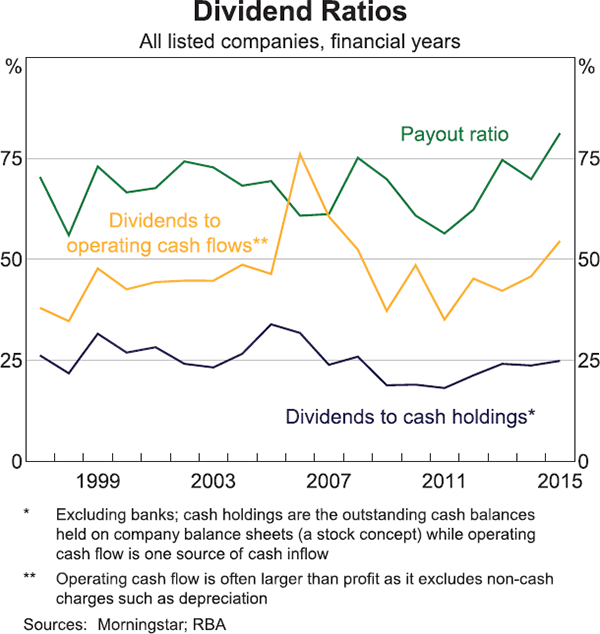
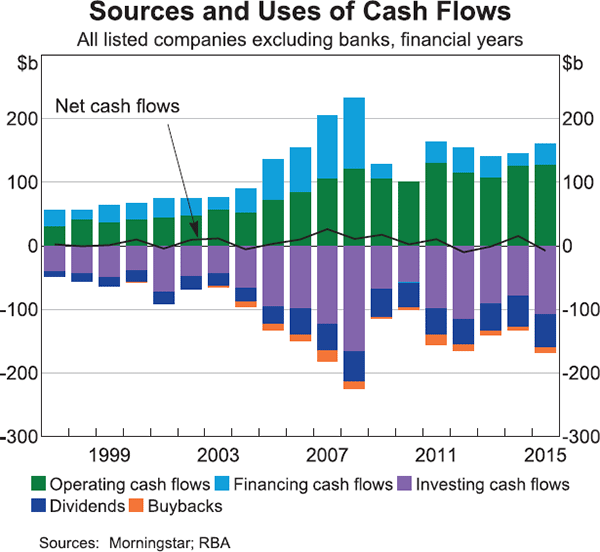
Sectoral Trends
Since 2010, dividend payout ratios have increased in the resources and banking sectors, while they have generally displayed no trend in the other sectors (Graph 5). For companies paying dividends, the payout ratios do not appear to be unusually high relative to history. Sizeable losses among resources companies (that aren't currently paying dividends) explain why the payout ratio is currently above 100 per cent when all listed companies in the resources sector are considered.
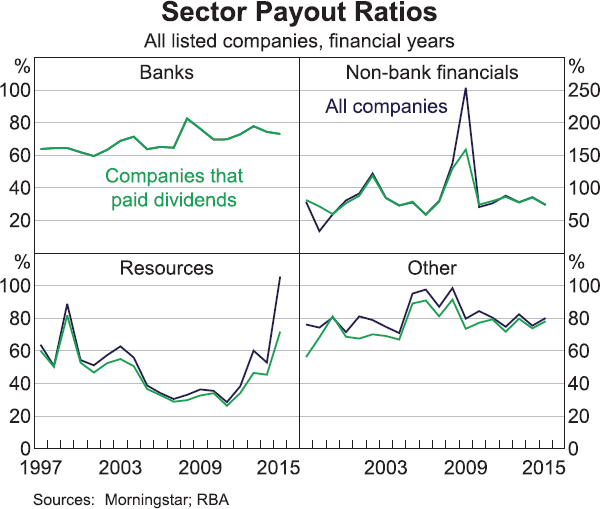
The large swings in the payout ratio of the resources sector over the past decade have had a significant influence on aggregate trends. These swings correspond roughly with the payout ratio falling during the investment phase of the resources boom, and rising as the resources boom shifted into the production phase. The fall in the payout ratio during the investment phase occurred alongside a sharp rise in profits in the sector and is consistent with resources companies largely using retained earnings rather than other sources of funding to finance the corresponding resources investment boom over this period (Arsov, Shanahan and Williams 2013) (Graph 6). However, payout ratios have risen sharply in recent years, albeit from a low level, as the transition to the production phase has coincided with a decline in earnings alongside lower commodity prices and some major companies in this sector maintaining, until recently, progressive dividend policies.
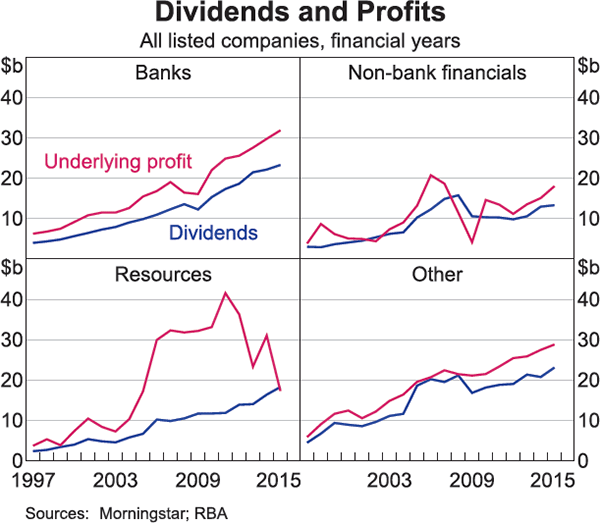
The payout ratio in the banking sector has been on an upward trend over the past decade to be just below 75 per cent in aggregate. In all sectors outside of resources, payout ratios spiked higher during the global financial crisis, as companies smoothed payments to shareholders, reducing dividends but by less than the decline in earnings. This occurred most dramatically in the non-bank financial sector, where the fall in earnings was particularly marked. The payout ratio for dividend-paying companies in the ‘other’ sector has increased modestly relative to pre-crisis levels.
Dividends are also usually concentrated among the largest companies, and this is borne out in the Australian data. The increase in dividend distributions over the past decade has been entirely driven by the ASX 200 companies, and particularly by the largest dividend payers (Graph 7). The 10 largest dividend payers vary over time, but usually include the major banks, the major diversified miners, Telstra Corporation and the major supermarkets. The distributions of the largest payers account for more than half of total dividend payments. However, in aggregate, the top 10 dividend payers are expected to reduce dividend payments in 2015/16 for the first time since the global financial crisis, with the major miners having announced a shift away from progressive dividend policies. Total dividends paid by the remainder of ASX 200 companies remains below its peak in 2007, while the majority of listed companies outside of the ASX 200 do not pay dividends.
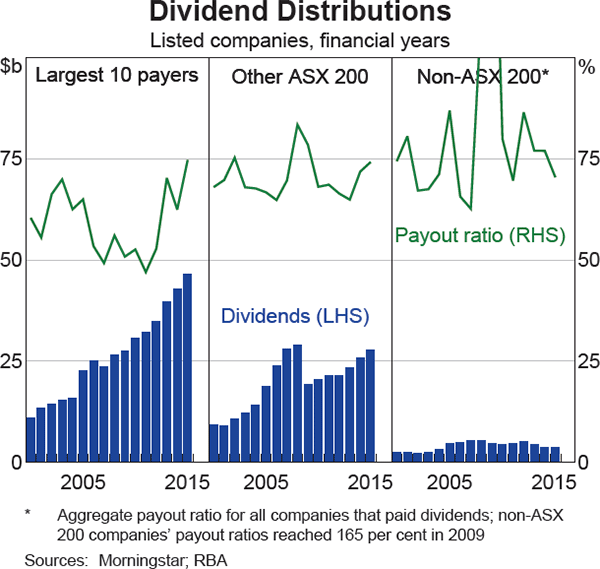
The concentration of dividend payments among the largest companies highlights the importance of their decisions for the overall payout ratio for the ASX 200. Not surprisingly, these companies are also mainly the traditional blue chip stocks favoured by Australian retail investors. This may reflect a preference by these investors towards well-known companies, but it is also consistent with the suggestion that retail investors may have a preference for dividend-paying stocks.
The Commitment to Paying Dividends
The theory and sectoral evidence are consistent with dividends being typically more stable than earnings. Companies may be reluctant to reduce dividend payments in dollar terms, even though many companies express their dividend policy in terms of a target payout ratio. Other companies have policies that suggest a commitment to a dollar amount; however, some large resources companies have recently shifted away from such policies, adopting instead policies that are linked to payout ratios, but with some flexibility to deviate based on managerial discretion.
Firm-level data, covering around 400 to 500 dividend-paying companies for each year, confirm that in general a majority increase the dollar value of dividend payments each period (Graph 8). Earnings do have some influence on dividend decisions. Around three-quarters of dividend-paying companies increase their dividend payments in periods where earnings have increased.[2] In contrast, when earnings fall (not including when a loss was recorded), a majority of companies still seek to increase dividends or keep them unchanged from the previous period. This apparent reluctance to cut dividends may support dividends in an environment of weaker profit growth and appears to be a factor in the increase in payout ratios in the past year. Notwithstanding this, most companies have usually been willing to reduce dividend payments in periods when they record a loss.
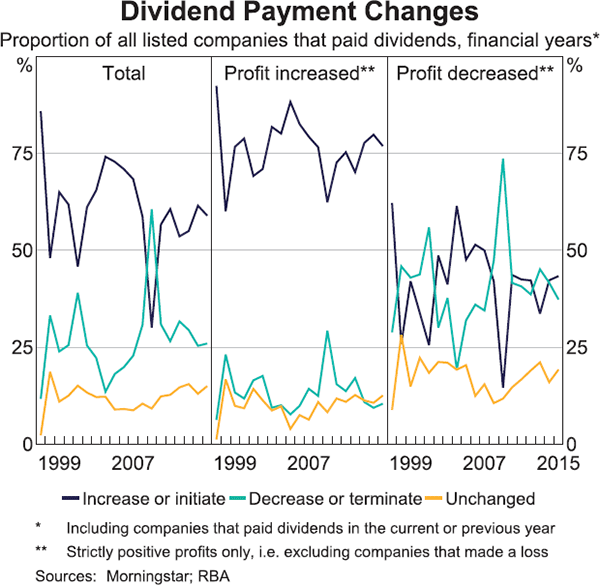
Companies' potential reluctance to reduce dividends has been evident at times in company statements regarding their commitment to established dividend policies. It is also evident in the major banks paying out around $23 billion in dividends in 2014/15, an increase on the previous year, while also choosing to raise around $23 billion in equity in 2015, including through the use of DRPs.
Shareholder Demands on Dividend Payments
A number of explanations have been suggested for the strong rise in dividend payments by Australian companies over recent years. One potential explanation is an increase in shareholder demand for dividends. If shareholders are now more risk averse, they may have a stronger preference for companies to return cash as dividends rather than retaining it for investment. Shareholders may also prefer to limit their exposure to particular companies, and dividend payments may be cost-effective relative to the option of reducing their stake via selling shares. It may also be that companies have committed to raising dividends as a signal about the ongoing viability of the company.
Investors may have also increased their demand for ‘bond-like’ equities, in response to interest rates falling to historical lows. That is, in rebalancing their portfolios towards equities, they might favour dividend-paying stocks, particularly among investors with strong preferences for income (for example, retirees) or who can utilise franking credits. The above explanations may be interrelated as a relatively more risk-averse group of investors may have a greater influence in equity markets while having a preference for specific high-dividend-paying equities. The ageing of the population may further reinforce a shift towards risk aversion among equity investors, with preferences for financial risk-taking generally declining with age (Lowe 2014).
Direct evidence for shareholder preferences and demands is generally not available. However, data which are consistent with this explanation are available for ASX 200 companies – the main dividend payers. An implication of Modigliani and Miller's (1961) theory is that the total returns (share price plus dividends) of investing in shares should not depend on whether the company pays high or low dividends. However, high-dividend-paying equities have outperformed the broader Australian index since 2011 on a total returns basis, which would be consistent with a shift in preferences towards these stocks. High-dividend-paying equities have also tended to have higher valuations, as measured by the forward price-to-earnings (P/E) ratio, and this gap has increased over recent years (Graph 9). This might reflect investors requiring a relatively lower equity risk premium for companies that pay higher dividends. Alternatively, these metrics could indicate that high-dividend-paying companies are also generally companies that have a stronger outlook for earnings.
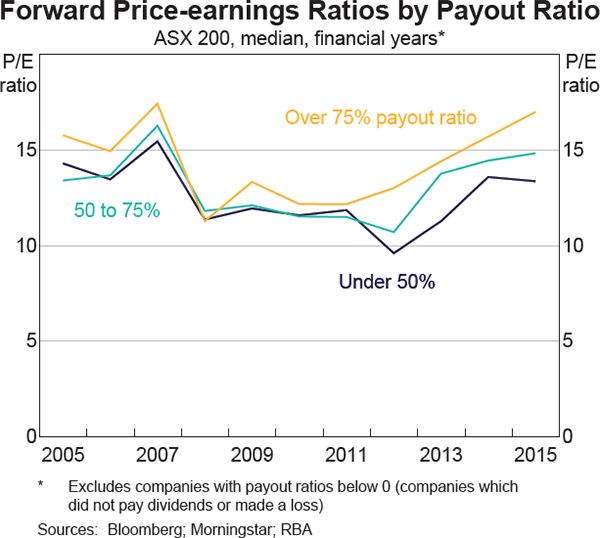
Companies with a higher retail shareholder base also generally maintain higher payout ratios, although these data are only available from 2011 (Graph 10). The available data are consistent with retail investors generally selecting higher-dividend-paying stocks but do not support the claim that retail shareholder demands have led to higher dividends being paid. Indeed, payout ratios have trended higher across all companies, not just those with a relatively high retail shareholder base.
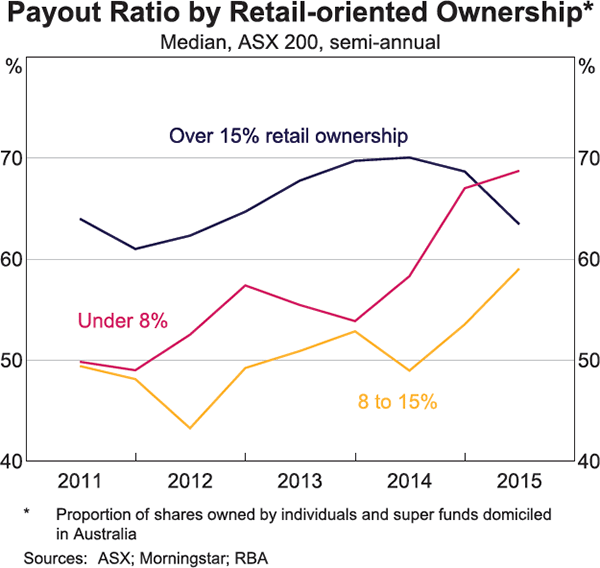
Investment Decisions and Dividend Payments
Shareholder pressure to pay dividends and demands to meet high investment hurdle rates have the potential to reduce the available funding for investment projects. The OECD (2015) recently noted that weak business investment globally may reflect increased pressure on companies from activist investors favouring the short-term benefit of shareholder distributions over longer-term investments.
Management teams also may perceive fewer ‘viable’ investment opportunities. As a result, the firm may return excess funds to investors or face concerns from investors about management's ability to act as their agent. A higher hurdle rate on investment may reflect factors such as a higher equity risk premium demanded by investors, lower assumptions about economic growth and/or a reduced appetite for risk of the firm's management. On the other hand, the decline in the real risk-free bond rate should both lower the firm's cost of capital and returns demanded by investors. However, evidence from RBA liaison suggests that investment hurdle rates used by corporate boards can be very sticky (Lane and Rosewall 2015).
There is some evidence to support the claim that businesses perceive insufficient investment opportunities and hence have distributed dividends rather than increased cash holdings to fund investment. The weakness in business investment relative to dividend payments is evident in the increase in the ratio of dividends to capital expenditure, particularly for resources companies (Graph 11).
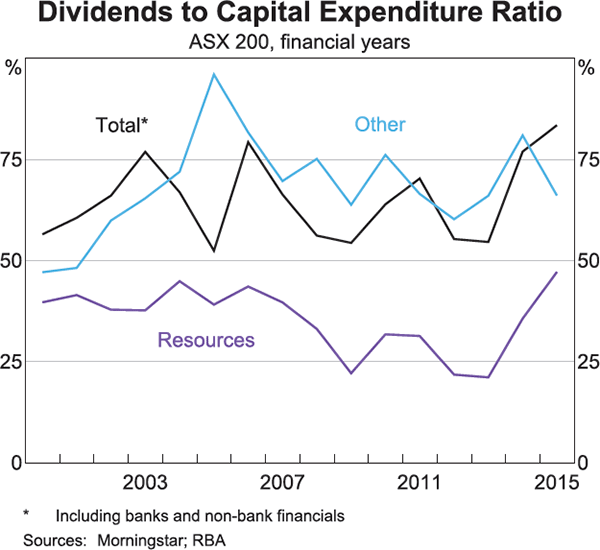
Further, there is little evidence that ASX 200 companies have been constrained with regards to funding, and non-financial companies have held a larger proportion of their assets as cash compared with the pre-crisis period. This accumulation of cash, the relatively low level of company gearing and the availability of external finance at a relatively low cost appear consistent with companies perceiving fewer investment opportunities and/or having a reduced willingness to invest.[3]
While it is difficult to find direct evidence for the direction of the relationship between dividends and physical investment, indirect evidence provides some support for the idea that companies have found fewer ‘viable’ investment opportunities and therefore returned excess funds as dividends. For example, Tobin's q ratio, a commonly used proxy for investment opportunities, remains below its 2007 peak in aggregate.[4] Not surprisingly, the fall is most marked in the resources sector, which had a large investment boom from the mid 2000s and now faces much more challenging conditions given lower commodity prices (Graph 12).
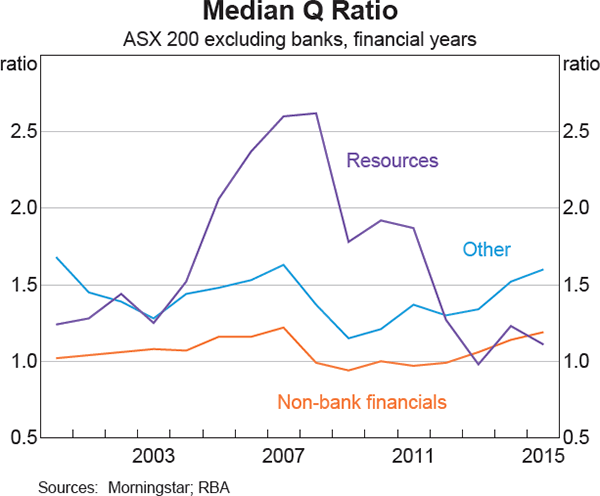
Conclusion
Growth in dividends over the past few years has primarily been driven by the banks and major miners and has also been associated with an increase in the aggregate payout ratio. This has occurred at a time of slower growth in aggregate earnings and has raised questions about the sustainability of dividend payments, particularly given some apparent reluctance by companies to reduce dividend payments even when profits decline. However, dividend payments are now expected to fall in 2015/16 for the first time since the financial crisis, given falls in resources sector earnings, and reflecting recent announced changes to dividend policies by the major miners. It is generally difficult to assess the motivations of company decision-makers in paying dividends. The recent growth in dividend payments may have been influenced by shareholder demands, associated with an increase in shareholder risk aversion or an increase in the demand for dividend-paying stocks at a time when traditional income-paying investments (cash and bonds) are offering very low yields. It could also reflect companies perceiving fewer viable investment opportunities and deciding instead to return excess funds to shareholders. The data presented here offer modest support for both of these possibilities.
Footnotes
The author is from Domestic Markets Department. [*]
The system of dividend imputation allows companies to attach franking credits to the dividend, which are drawn from a franking credit balance based on past company taxes paid by the company. Shareholders pay tax on the franked component of a dividend if their marginal income tax rate is above the company tax rate, or alternatively receive a tax refund if their marginal tax rate is below the company tax rate. [1]
The global financial crisis stands out as an exception to the above behaviour, with profitable firms more willing to reduce dividends, potentially reflecting the tighter funding conditions at that time. [2]
The book value gearing ratio – the ratio of debt to equity – remains below its average over the past 20 years for non-financial listed corporations. [3]
The q ratio is the ratio of the market to book value of a company and measures the market's assessment of the value added by a company through the combination of its assets above the sum of its components. The implication is that the higher the q ratio is above 1, the higher the company's ability is to add value, and the more that new investments may presumably also be valued above the cost of capital. However, the q ratio may just be indicative of share market overvaluation. [4]
References
Arsov I, B Shanahan and T Williams (2013), ‘Funding the Australian Resources Investment Boom’, RBA Bulletin, March, pp 51–61 .
Baker M and J Wurgler (2004), ‘A Catering Theory of Dividends’, The Journal of Finance, LIX(3), pp 1125–1165.
Brav A, JR Graham, CR Harvey and R Michaely (2005), ‘Payout Policy in the 21st Century’, Journal of Financial Economics, 77, pp 483–527.
Lane K and T Rosewall (2015), ‘Firms' Investment Decisions and Interest Rates’, RBA Bulletin, June, pp 1–8.
Lowe P (2014), ‘Demographics, Productivity and Innovation’, Speech to The Sydney Institute, Sydney, 12 March.
Miller MH and K Rock (1985), ‘Dividend Policy under Asymmetric Information’, The Journal of Finance, 40(4), pp 1031–1051.
Modigliani F and MH Miller (1961), ‘Dividend Policy, Growth, and the Valuation of Shares’, The Journal of Business, 34(4), pp 411–433.
Mueller D (1972), ‘A Life Cycle Theory of the Firm’, The Journal of Industrial Economics, 20(3), pp 199–219.
OECD (Organisation for Economic Co-operation and Development) (2015), ‘Corporate Investment and the Stagnation Puzzle’, OECD Business and Finance Outlook 2015, OECD Publishing, Paris.